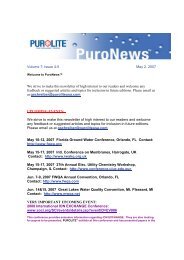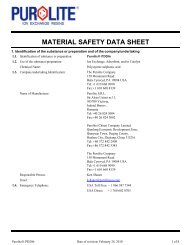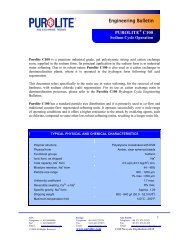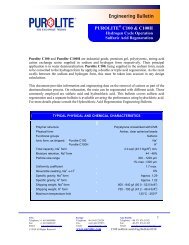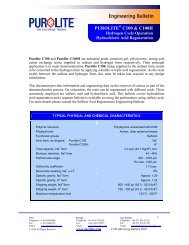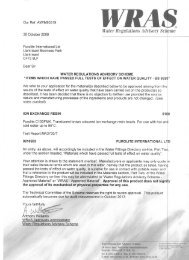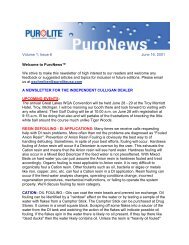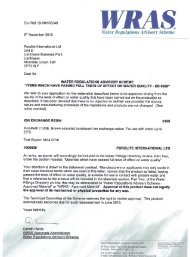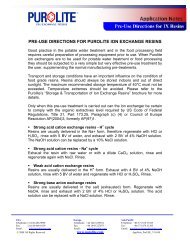LABORATORY TESTING OF ION EXCHANGE RESINS - Purolite.com
LABORATORY TESTING OF ION EXCHANGE RESINS - Purolite.com
LABORATORY TESTING OF ION EXCHANGE RESINS - Purolite.com
Create successful ePaper yourself
Turn your PDF publications into a flip-book with our unique Google optimized e-Paper software.
PUROLITE INTERNAT<strong>ION</strong>AL LIMITED<br />
A Practical Guide to carrying out Laboratory<br />
Trials on Ion Exchange Resins and Adsorbents
<strong>LABORATORY</strong> <strong>TESTING</strong> <strong>OF</strong> <strong>ION</strong> <strong>EXCHANGE</strong> <strong>RESINS</strong><br />
1.0 INTRODUCT<strong>ION</strong><br />
This is a <strong>Purolite</strong> guide to Chemists and Process Engineers on how to carry out simple<br />
evaluations of ion exchange and adsorbent resins in the laboratory to see if a<br />
particular process will work.<br />
Depending on the results obtained and the depth of work carried out it may enable<br />
you to optimise some of the operating conditions. While it may not give you sufficient<br />
information to design a full scale plant, it should show if a process is viable and<br />
enable you to design a larger pilot plant if necessary.<br />
Much development work by <strong>com</strong>panies is carried out in secret to develop new and<br />
sometimes novel processes that can be patented. Much expensive development time<br />
can be saved by discussing your exact requirements with <strong>Purolite</strong> International<br />
Limited. We are willing to enter into confidentiality agreements with clients so that<br />
they are able to obtain the maximum from our help and support.<br />
2.0 RESIN VOLUME<br />
Where single beds are being tested approximately 100 ml of resin will be sufficient<br />
for an initial test. Remember on some applications where the inlet load is very low, it<br />
will require a very large amount of solution to be processed through the bed to reach<br />
exhaustion and this may make each test too long for you to <strong>com</strong>plete the work<br />
quickly.<br />
3.0 EQUIPMENT<br />
To carry out initial trials a 25mm diameter glass or sometimes a plastic column is<br />
suitable. A glass column with a sintered glass bottom is ideal, but otherwise a column<br />
with a rubber stopper at each end with a glass tube through each stopper will work. If<br />
this type of simple equipment is used then a nylon cloth over the surface of each<br />
rubber stopper covered to a depth of 15-25 mm with small diameter glass beads (3mm<br />
diameter) at the bottom of the column will act as an adequate collection system.<br />
If the column does not have a valve connection then rubber tubing and a screw clamp<br />
on the tubing can be used as an on/off valve and to control the flow rate.
4.0 RESIN STORAGE<br />
Sometimes <strong>Purolite</strong> supplies resin to test, but unfortunately the trials cannot be carried<br />
out immediately. If you are storing resins prior to testing please ensure they are not<br />
left open to the atmosphere or allowed to dry out. They should also be kept away from<br />
strong sunlight and adverse temperatures.<br />
5.0 PRECONDIT<strong>ION</strong>ING THE RESIN<br />
Never test resins with very shallow bed depths. The minimum bed depth of 150 mm<br />
should be avoided if possible. In most applications the process will improve if the bed<br />
depth is increased.<br />
Backwashing<br />
Once the resin is loaded in the column the resin should be backwashed so that the<br />
resin bed is fully classified. This is carried out with demineralised water in an up flow<br />
manner. 10-15 minutes should be sufficient to classify the bed. The resin bed will<br />
expand and the larger particles will fall towards the bottom of the bed and the smaller<br />
beads will be nearer the surface when they are allowed to settle.<br />
Following this process and depending on the particle size range of the resin, you will<br />
notice that the height of the resin will have increased. This is now the height (volume)<br />
of the resin you must use for all your calculations concerning the test work.<br />
Rinsing<br />
When samples are sent out from our store the resin is usually taken from production<br />
batches but it may have been in our store for some time. Before carrying out your<br />
trials rinse the resin with demineralised water to reduce any leachables that can arise<br />
in storage before carrying out the test. 5-10 bed volumes should be sufficient in many<br />
applications. In high purity applications please refer to <strong>Purolite</strong>.<br />
None Water Applications<br />
Unless a specially prepared product as been produced by <strong>Purolite</strong>, the resin will be<br />
delivered in a moist form and the beads will contain water. If the samples are to be<br />
tested in a non-aqueous application, or where the water content is very low or critical<br />
then the first step should be to displace the water with the process liquor. It is best to<br />
use treated product, otherwise your preconditioning treatment will actually be loading<br />
the resin with the material you want to capture on the beads. In some test work it is<br />
possible to use a suitable solvent such as acetone or alcohol to displace the water.
6.0 PROCESS PARAMETERS<br />
Depending on the application the process conditions for the resin will vary widely.<br />
In many water applications where the loading is small and conventional ion exchange<br />
is taking place then flow rates through the resin can be high (Up to 50 BV/h) and<br />
sometimes even greater flow rates are used.<br />
In special process applications, or where highly selective removal is required then<br />
flow rates can be much lower (1-10 BV/h)<br />
Where regeneration of a resin is undertaken this is normally carried out at relatively<br />
low flow rates to achieve maximum removal from the beads (1-6 BV/h) and is<br />
followed by a slow rinse at a similar flow rate to maximise the removal of the<br />
regenerant.<br />
Finally a rinse at a higher or service flow rate is normally carried out.<br />
In non-aqueous process applications the resin is often regenerated in the aqueous<br />
state. Under these circumstances the process liquor must first be displaced with water.<br />
This is often referred to as “sweetening off” and after regeneration the water is<br />
displaced with process liquor and is called “sweetening on”. These terms derive from<br />
the sugar industry where ion exchange resins and absorbents are used widely.<br />
Parameters:<br />
Resin volume 50 – 250 ml<br />
Resin bed depth 150-600 ml (classified)<br />
Service flow rate 2 – 50 BV/h (BV/h = Bed volumes per hour)<br />
Regenerant flow rate 2 – 6 BV/h<br />
Regenerant contact time 15 – 60 minutes<br />
Slow displacement rinse 1 – 2 BV<br />
Final fast rinse 2 – 10 BV<br />
For regeneration chemicals, concentrations and quantities and details on sweetening<br />
on an off we strongly re<strong>com</strong>mend you refer to <strong>Purolite</strong> for guidance.
7.0 REGENERAT<strong>ION</strong><br />
Many different ion exchange regeneration processes have been developed both in<br />
aqueous and non-aqueous applications. The simplest method of regeneration of<br />
regeneration is co-flow (Often referred to as co-current) where the regenerant passes<br />
downflow through the resin in the same direction as the service flow.<br />
More widely used now is counter flow regeneration (often referred to as counter<br />
current or reverse flow). Here the regenerant passes in the opposite direction to the<br />
service flow and this results in much lower leakage from the bed. Counter flow<br />
regeneration is more difficult to set up in the laboratory and reference to <strong>Purolite</strong><br />
International Limited for guidance is re<strong>com</strong>mended. Parameters such as bed depth can<br />
be more critical as well as ensuring a means of retaining the bed in a fixed location<br />
has to be devised during the upflow passage of the testing solution or regenerant.<br />
In co-flow regeneration the first stage of every regeneration cycle should be to<br />
backwash the bed. This relieves any <strong>com</strong>paction and can be used to remove any<br />
filtered out suspended matter. Solutions or water containing more than trace levels of<br />
solids should be removed by filtration prior to the test column.<br />
Regeneration followed by a slow displacement rinse and then final rinse can then be<br />
carried out. In laboratory work it is often better if these three steps are carried out with<br />
demineralised water for regenerant dilution and the rinse stages as this ensures there is<br />
no ionic loading of the resin and makes calculations of capacity easier.<br />
8.0 SERVICE OPERAT<strong>ION</strong><br />
Once a trial run has begun the resin should be allowed to continue to operate through<br />
to exhaustion. You should not stop the experiment in mid cycle. Most ion exchange<br />
reactions are reversible and hence once the solution is stopped the solution tries to<br />
reach an equilibrium and the ions <strong>com</strong>e back off the resin into solution. This can<br />
cause premature exhaustion and leads to false results being obtained.<br />
It normally takes two or three cycles from when the resin is first tested to obtain<br />
reliable information from your test work and you should aim to get three consecutive<br />
cycles giving consistent results before changing any operating conditions to try to<br />
optimise the performance.<br />
Under normal conditions tests the bed must remain covered with solution. Never drain<br />
the column and introduce air into the bed as this will give poor performance and air<br />
bubbles are difficult to remove.
9.0 EQUIPMENT SET UP<br />
Depending on the nature of the trial you may be able to feed the column by gravity or<br />
have to use a pump. If gravity feed is used then the pipework from the column can be<br />
arranged in a U shape so that it rises to a level above the top of the bed to keep the<br />
resin flooded at all times.<br />
Where gravity or pumped systems are used it is essential that you have ready made up<br />
solutions of regenerant and demineralised water for the regeneration process made up<br />
and stored ready.





